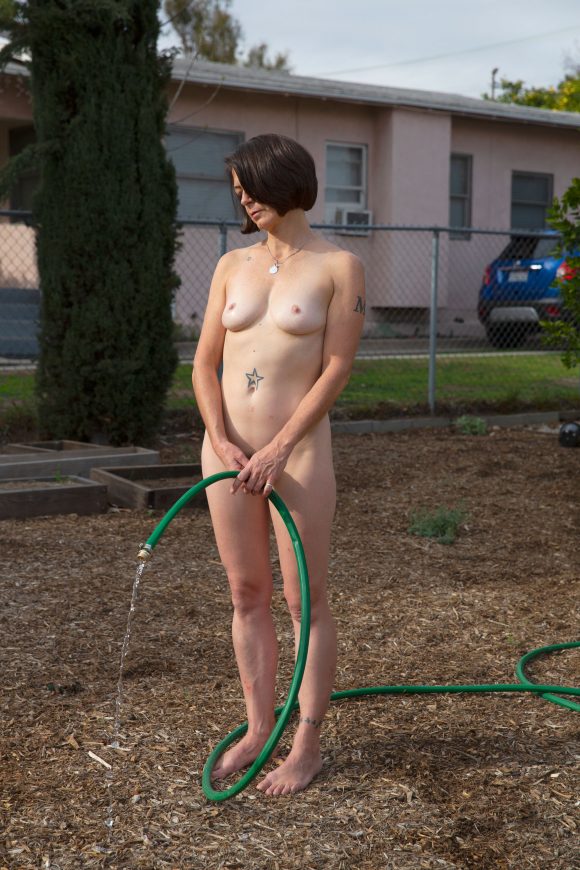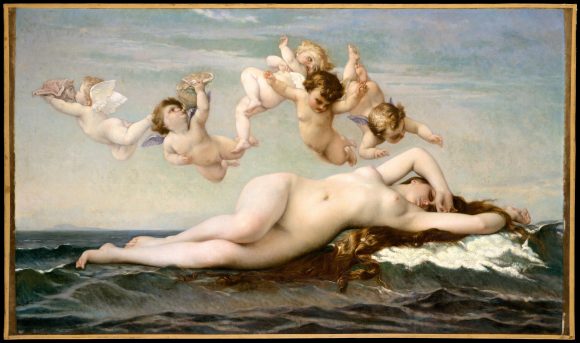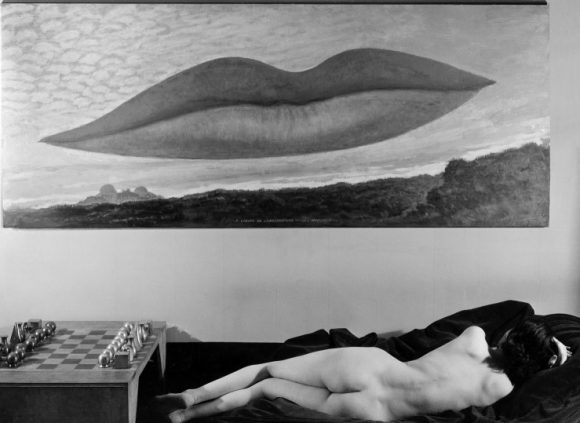Micol Hebron Art, activism, and the female body
April 28, 2020
The Escalette Collection is proud to announce the addition of three new pieces to our collection, by performance artist and Chapman professor, Micol Hebron. She seeks to challenge the way female-presenting bodies are viewed by society, through performance art and photography, and for her viewers to consider women in art, and the imbalance between women as art subjects and women as artists.

Micol Hebron, Domestic, Archival inkjet print, 2016. Purchased with funds from the Ellingson Family.
Domestic and Commute are part of a series called “(In) Decent Exposure,” in which Hebron uses her body as the medium, and in which she is “nude in public or semi-public places, doing very banal, everyday things – things that are not sexy,” such as watering her lawn or driving. She challenges the concept of private spaces, like a car or front lawn, where one is still able to be viewed by others in the outer public sphere. Is the nude body still inappropriate if it’s occupying a private space, where the person is not able to control who views them and how? Hebron also questions the way female-presenting bodies are seen as sexual objects, regardless of the task the body is performing, such as lawn watering. She wants to get to a point where the naked body is not viewed as sexual or inappropriate, but merely as a body, as well as equality and autonomy for all bodies, no matter what they present as.
Hebron is also aware of the humor her works express. “I think the idea of driving along the LA freeways without my top on, or of watering my lawn nude is pretty funny (World Naked Gardening Day is May 2nd by the way!). For me these poses are related to the familiar fantasy fear of showing up to work or class naked.” The photos were taken outside of Hebron’s L.A. home and were shot by professional photographer Alex Aristei, who has photographed many of her works. Domestic was also inspired by photographs taken by Larry Sultan of life in the San Fernando Valley, several of which depict women watering their lawns with a hose.
Cabarary: Observatory Venus at the Lover’s Hour is part of another series in which Hebron combines and recreates notable works from art history. This piece combines Alexandre Cabanel’s Birth of Venus and a photograph by Man Ray of a nude woman laying underneath his work Observatory Time: The Lovers. Hebron states that her works “intentionally ‘confuse’ images and authorship, fusing two or more pieces that have formal similarities.” Her inspiration for recreating famous works of art was born out of her art education background, creating an “artistic, authorial identity crisis” in the face of so many white male artists throughout art history.

Micol Hebron, Cabaray: Observatory Venus at the Lover’s Hour, Archival inkjet print, 2010. Purchased with funds from the Ellingson Family.
This work will soon be on display in the Wilkinson College Dean’s Suite in Roosevelt Hall.
- Alexandre Cabanel, The Birth of Venus, oil on canvas, 1875. The Metropolitan Museum of Art.
- Man Ray, Observatory Time: The Lovers, photograph, 1936. Private collection.
The photo was taken on the salt flats of the Great Salt Lake in Utah, where Hebron was working as a curator in the Museum of Contemporary Art. The silhouette of the Griffith Park Observatory, located in L.A., was photoshopped in afterward, which Hebron says is seen in Man Ray’s painting, as well as “a nod to my hometown of Los Angeles.” The lips above Hebron belong to an anonymous friend, who is both an artist and a former pageant queen. Hebron’s pose references the reclining Venus in Cabanel’s painting as well as the woman laying on the couch beneath Observatory Time: The Lovers.
Hebron offers encouragement to feminist artists at Chapman, female, male, or nonbinary.
“Your voices matter, a lot. We need to hear from you, to see your art. Your experiences matter, your thoughts matter, your creative vision matters. We are all enriched when we can experience your truth as expressed through your art. Don’t let the world continue to silence you! The more you speak out, the more you will realize how many others have had experiences similar to yours – and you can empower and support each other. We HAVE to build solidarity in this life if we are to survive and thrive. Speaking our truths and listening to the truths of others is a great way to do that! I support you fully!”
We invite you to explore all the works in the Escalette Collection by visiting our eMuseum.
Wilkinson College of Arts, Humanities, and Social Sciences is the proud home of the Phyllis and Ross Escalette Permanent Collection of Art. The Escalette Collection exists to inspire critical thinking, foster interdisciplinary discovery, and strengthen bonds with the community. Beyond its role in curating art in public spaces, the Escalette is a learning laboratory that offers diverse opportunities for student and engagement and research, and involvement with the wider community. The collection is free and open to the public to view.





